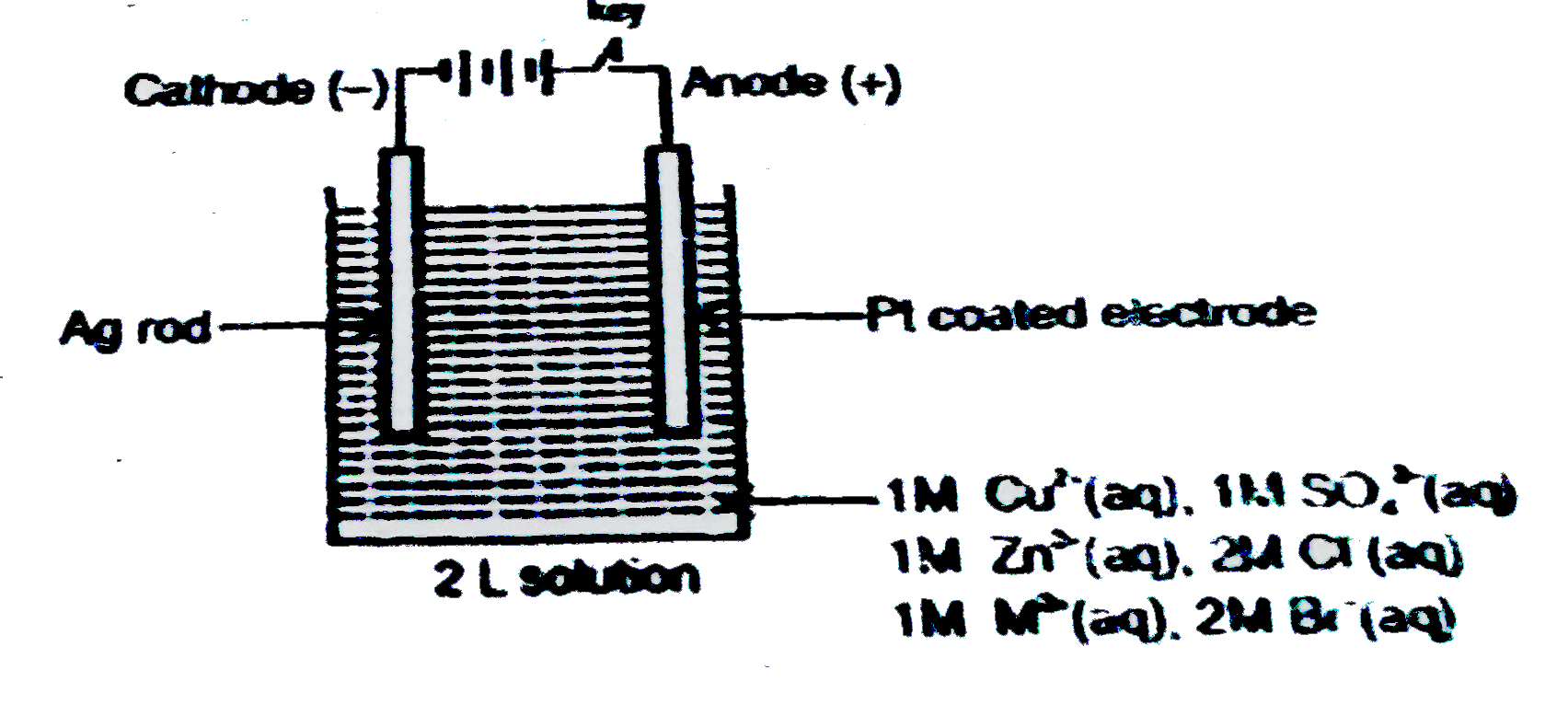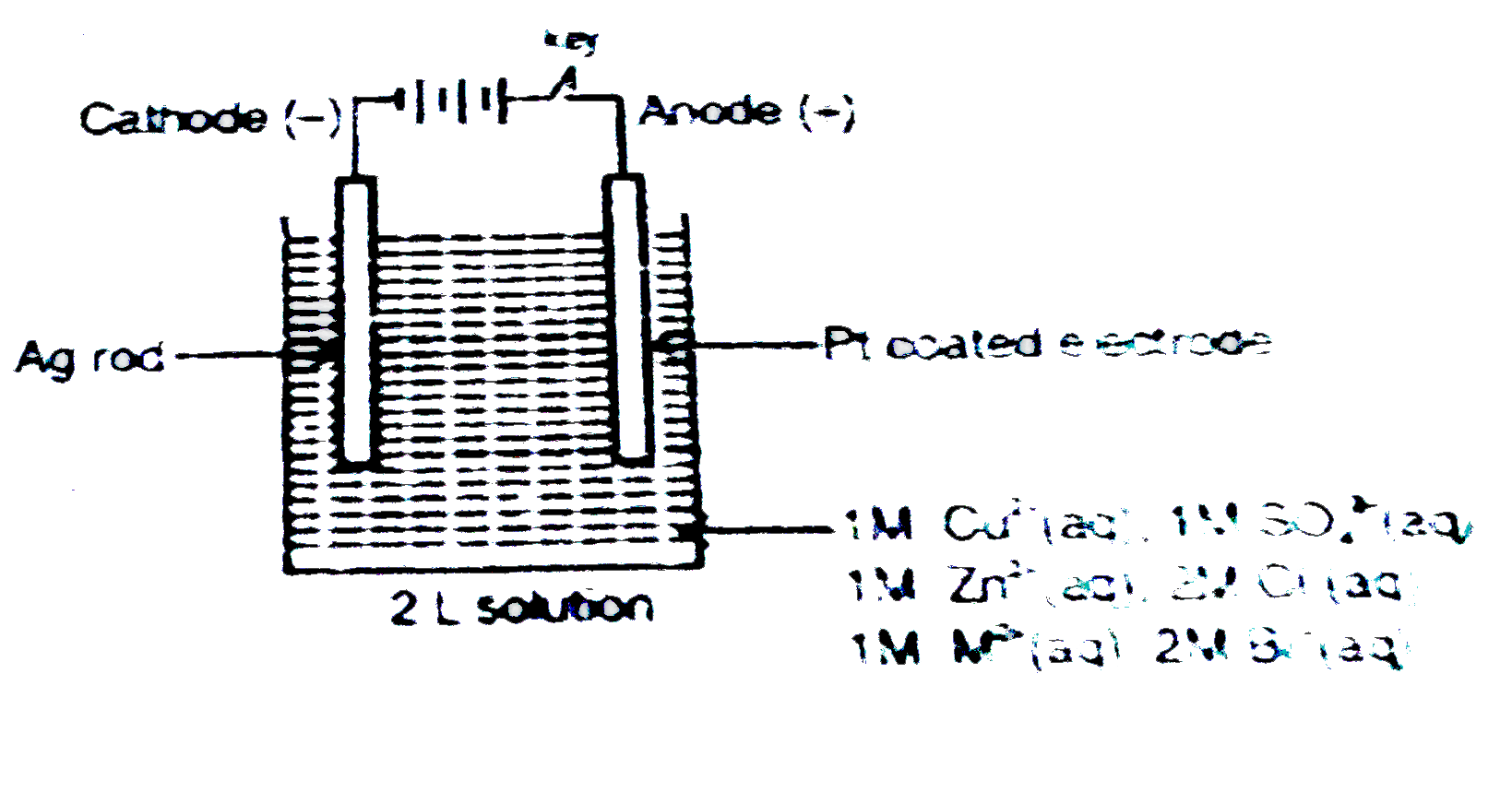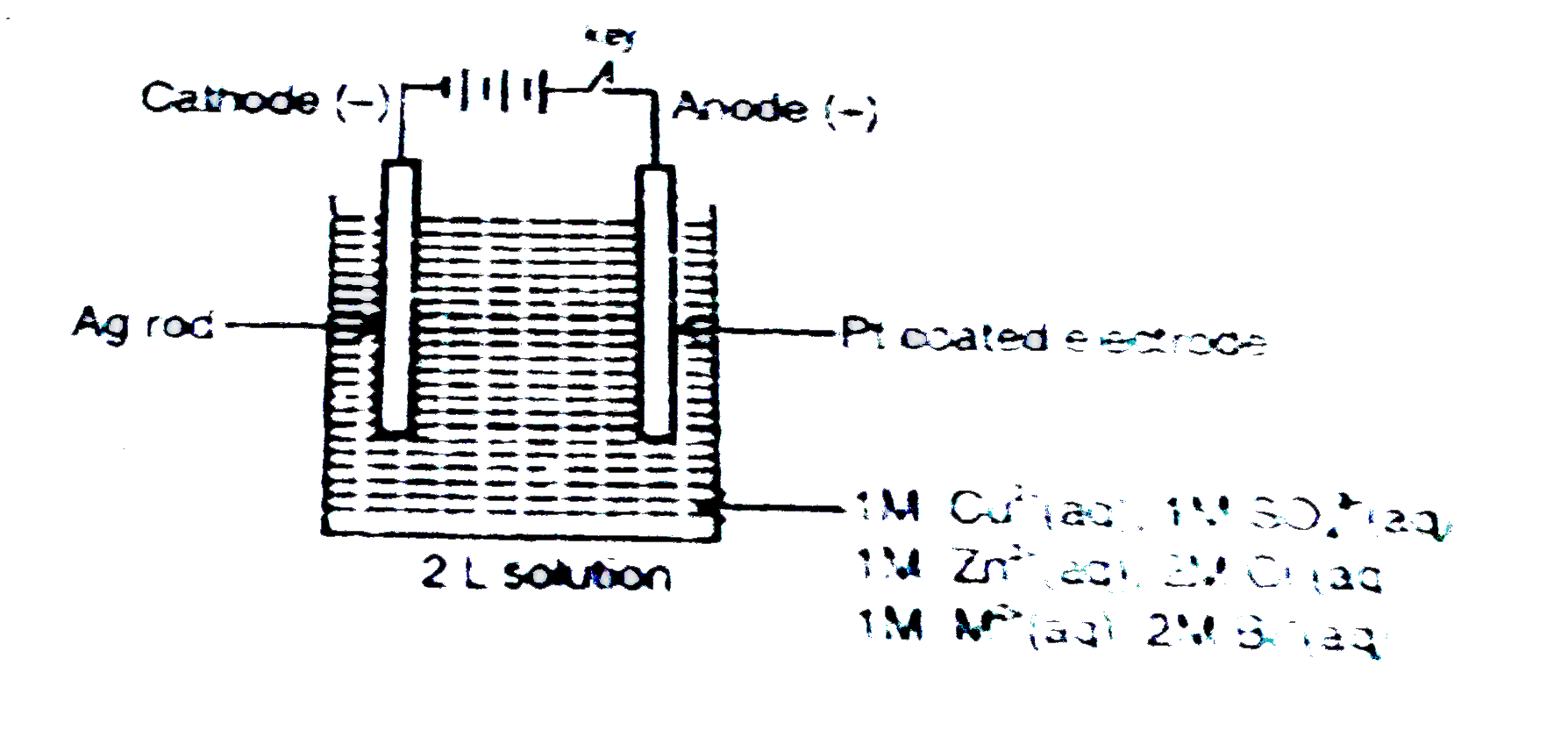The process of using an electric current to bring about chemical change is called electrolysis.Electrolysis is a processes of oxidation and reduction at the respective electrodes due to external current passed in the electrolyte.
The product obtained during electrolysis depends on following factors.
The nature of the electrolyte
The concentration of electrolyte
The nature of the electrode.
Consider the electrolysis of following cell containing aq. solution of CuSO4,ZnCl2 and MBr2 by using pure silver rod as a cathode and Pt electrode as anode.Assume that M2+ does not further oxidise and can not form complex with NH3 Assume no hydrolysis of any ion.
E0Cu2+/Cu=0.35V,E0M2+/M=−0.10V,E0Zn2+/Zn=−0.76V,E0H2O/H2=−0.828V,E0Ag+/Ag=0.80V,2.303RTF=0.06
After passing 20 amp current from battery for 28950 sec.the remaining conc. of ions in solution given in passage would be: (Assume current efficiency to be 100%)

A
[Cu2+]=0.5M,[M2+]=0.5M,[Zn2+]=0.1M
B
[Cu2+]≈0M,[M2+]=0.5M,[Zn2+]=0.5M
C
[Cu2+]=0.5M,[M2+]=0.5M,[Zn2+]=0.5M
D
[Cu2+]≈0M,[M2+]=0.5M,[Zn2+]=1M
Text Solution
The correct Answer is:D
Deposition order Cu>M>Zn
Cu required ⇒I×t96500=wE
20×t=1×2×2×96500
t=19300 sec.
In 28950-19300=9650 sec M2+, will deposit as M.
mole of M×2=20×965096500
mole of M deposit =1
Initial mole of M2+=1×2, remain M2+ moles =2-1=1 , [M2+]=12=0.5
|
Topper's Solved these Questions
Similar Questions
Knowledge Check
The process of using an electric current to bring about chemical change is called electrolysis.Electrolysis is a processes of oxidation and reduction at the respective electrodes due to external current passed in the electrolyte.
The product obtained during electrolysis depends on following factors.
The nature of the electrolyte
The concentration of electrolyte
The nature of the electrode.
Consider the electrolysis of following cell containing aq. solution of CuSO4,ZnCl2 and MBr2 by using pure silver rod as a cathode and Pt electrode as anode.Assume that M2+ does not further oxidise and can not form complex with NH3 Assume no hydrolysis of any ion.
E0Cu2+/Cu=0.35V,E0M2+/M=−0.10V,E0Zn2+/Zn=−0.76V,E0H2O/H2=−0.828V,E0Ag+/Ag=0.80V,2.303RTF=0.06
What will be the volume of gases formed at anode at STP by electrolysis of above solution after passing 20 amp current for 28950 sec. (Assume current efficiency to be 100% and one mole of gas occupies 22.4 L volume at STP).
 A44.8LBr2B22.4LBr2C22.4LCl2D44.8LCl2
A44.8LBr2B22.4LBr2C22.4LCl2D44.8LCl2The process of using an electric current to bring about chemical change is called electrolysis.Electrolysis is a processes of oxidation and reduction at the respective electrodes due to external current passed in the electrolyte.
The product obtained during electrolysis depends on following factors.
The nature of the electrolyte
The concentration of electrolyte
The nature of the electrode.
Consider the electrolysis of following cell containing aq. solution of CuSO4,ZnCl2 and MBr2 by using pure silver rod as a cathode and Pt electrode as anode.Assume that M2+ does not further oxidise and can not form complex with NH3 Assume no hydrolysis of any ion.
E0Cu2+/Cu=0.35V,E0M2+/M=−0.10V,E0Zn2+/Zn=−0.76V,E0H2O/H2=−0.828V,E0Ag+/Ag=0.80V,2.303RTF=0.06
If 36 mol of NH3(g) is passed in electrolytic solution given in comprehension (assume no volume change by addition of NH3),then what would be decreasing order of reduction potential of following :
 AM2+>Cu2+>Zn2+BCu2+>M2+>Zn2+CM2+>Zn2+>Cu2+DCu2+>M2+>Zn2+
AM2+>Cu2+>Zn2+BCu2+>M2+>Zn2+CM2+>Zn2+>Cu2+DCu2+>M2+>Zn2+During the electrolysis of aqueous solution of sodium chloride, pH of the electrolyte
ARemains constantBGradually incresesCGradually decreasesDDecreases first and then increases.
________ of electrolyte gets oxidised in electrolysis
View SolutionElectrolysis brings about a chemical change
View SolutionIn the process of electrolysis, the current is carried out inside the electrolyte by
View SolutionThe amount of an ion liberated on an electrode during electrolysis does not depend upon:
View SolutionIn the process of electrolysis , the positive and negative ions of the electrolyte are
View Solution
